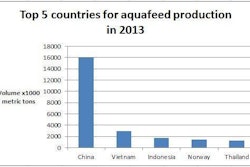
Aquaculture is the fastest growing animal food-producing sector; however, in the short term, the effects of Early Mortality Syndrome (EMS) continue to hit shrimp producers hard.
As cited in the June 2014 Feed International cover story, “Emerging trends in Latin American aquafeed production,” the volume of fish feed production is growing, but, depending on the region, the Latin American shrimp sector is struggling. While Ecuador reported a 20 percent increase in shrimp feed production, EMS dropped Mexico’s volume by two-thirds in 2013.
Other counties face a similar hurdle.
At VICTAM Asia, held in Bangkok in April 2014, I had the opportunity to sit down with the Thai Feed Mill Association’s (TFMA) president, Pornsil Patchrintanakul, and secretary general, Boontham Armsiriwat. In addition to a greater discussion about the state of the Thai feed industry, aquafeed production was a pertinent talking point. According to Armsiriwat, in 2013, EMS reduced Thailand’s aquafeed production by 50 percent.
“Last year was a bottom situation for Thai aquaculture,” Armsiriwat notes. “In the future, we think there are positive signs that it will recover, but it will take time — three to five years.”
Improved testing, feed additives and other risk management strategies have helped, but the industry is far from out of the weeds.
To read more about TFMA’s outlook for the Thai feed industry, visit my blog, “In The Mix.”














